Duchy of Carinthia
Duchy of Carinthia | |||||||||||||
|---|---|---|---|---|---|---|---|---|---|---|---|---|---|
| 976–1918 | |||||||||||||
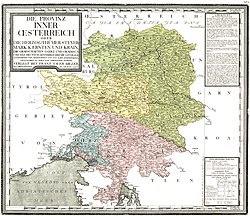 Carinthia (yellow) withinInner Austria,c. 1790 | |||||||||||||
| Status | Stateof theHoly Roman Empire(until 1806), Part of theHabsburg monarchy(from 1526), constituent land of theAustrian Empire(1804–67), Cisleithaniancrown land ofAustria-Hungary(from 1867) | ||||||||||||
| Capital | Sankt Veit an der Glan(Šentvid ob Glini) until 1518, thenKlagenfurt(Celovec) | ||||||||||||
| Common languages | |||||||||||||
| Government | Duchy | ||||||||||||
| Duke | |||||||||||||
• 976–978 | Henry I(first) | ||||||||||||
• 1916–1918 | Charles I(last) | ||||||||||||
| Historical era | Middle Ages | ||||||||||||
• CreatedDuchy | 976 | ||||||||||||
| 1335 | |||||||||||||
| 1379 | |||||||||||||
• JoinedAustrian Circle | 1512 | ||||||||||||
• Upper CarinthiacededtoIllyrian Provinces | 1809 | ||||||||||||
| 1815 | |||||||||||||
• Disestablished | 1918 | ||||||||||||
| 1920 | |||||||||||||
| |||||||||||||
| Today part of | |||||||||||||
TheDuchy of Carinthia(Latin:Ducatus Carinthiae;‹See Tfd›German:Herzogtum Kärnten;Slovene:Vojvodina Koroška) was aduchylocated in southernAustriaand parts of northernSlovenia.It was separated from theDuchy of Bavariain 976, and was the first newly createdImperial Stateafter the original Germanstem duchies.
Carinthia remained a State of theHoly Roman Empireuntil its dissolution in 1806, though from 1335 it was ruled within theAustriandominions of theHabsburgdynasty. A constituent part of theHabsburg monarchyand of theAustrian Empire,it remained aCisleithaniancrown land ofAustria-Hungaryuntil 1918. By the1920 Carinthian plebiscitein October 1920, the main area of the duchy formed the Austrian state ofCarinthia.
History
[edit]In the seventh century the area was part of the Slavic principality ofCarantania,which fell under the suzerainty of DukeOdilo of Bavariain about 743. TheBavarianstem duchy was incorporated into theCarolingian EmpirewhenCharlemagnedeposed Odilo's son DukeTassilo IIIin 788. In the 843 partition by theTreaty of Verdun,Carinthia became part ofEast Franciaunder KingLouis the German.From 889 to 976 it was theCarinthian Marchof the renewed Bavarian duchy, though in 927 the local CountBertholdof theLuitpolding dynastywas vested with ducal rights by theGermankingHenry the Fowler.After Berthold became Duke of Bavaria in 938, both territories were ruled by him. Upon his death in 948 the Luitpoldings, though heirs of the royalOttonian dynasty,were not able to retain their possessions, as KingOtto Ibought the loyalty of his younger brotherHenry Iwith the Bavarian lands.
Establishment
[edit]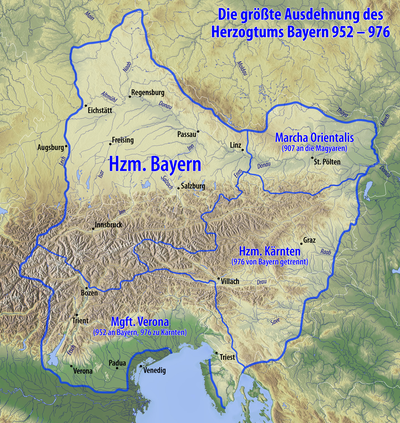
Duke Henry's sonHenry II"the Quarreller" from 974 onwards, revolted against his cousin EmperorOtto II,whereupon he was deposed as Duke of Bavaria in favour of Otto's nephew DukeOtto I of Swabia.At the same time Emperor Otto II created a sixth duchy in addition to the originalstem duchies,the new Duchy of Carinthia. He reverted the possession of the territories to the Luitpoldings, when he split Carinthia from the Bavarian lands and installed the former Duke Berthold's sonHenry the Youngeras duke in 976.
Over the centuries, the name 'Carinthia' (Kärnten) gradually replaced former 'Carantania'. The realm of the Carinthian dukes initially comprised a vast territory including the marches ofStyria(marchia Carantana),CarniolaandIstria;they also ruled over the ItalianMarch of Veronain the south. Nevertheless, Henry the Younger was the first and also the last Luitpolding duke; as he chose to join the unsuccessfulWar of the Three HenriesagainstEmperor Otto II,he lost Carinthia two years later and was succeeded by the Emperor's nephewOtto I,a scion of theSalian dynasty.Though Henry once again managed to regain the ducal title in 985, Carinthia upon his death in 989 fell back to the Imperial Ottonian dynasty in Bavaria.
Eppensteins and Sponheims
[edit]
Carinthia, however, remained a separate entity, and in 1012 CountAdalbero I of Eppenstein,Margrave of the Carinthian March (later Styria) since about 1000, was vested with the duchy by the last Ottonian emperorHenry II,while the Istrian march was separated and given to CountPoppo of Weimar.Adalbero was removed from office in 1035 after he had fallen out of favour with the Salian EmperorConrad II.In 1039 Carinthia was inherited by EmperorHenry IIIhimself, who split off the Carniolan march the following year and granted it to Margrave Poppo of Istria. In 1077, the duchy was given toLuitpold,again a member of theEppensteinerfamily, which, however, became extinct with the death of Luitpold's younger brotherHenry III of Carinthiain 1122. Upon his death the duchy was further reduced in area: a large part of the Eppenstein lands in what is todayUpper Styriapassed to MargraveOttokar II of Styria.
The remainder of Carinthia passed from Duke Henry III to his godchild Henry from theHouse of Sponheim,who ruled as Henry IV, from 1122 to his early death the following year.[1]The most outstanding of the Spanheim dukes wasBernhard,the first Carinthian duke who was actually described and honoured in documents as "prince of the land".[1]The last Spanheim duke wasUlrich III;he signed an inheritance treaty with his brother ArchbishopPhilip of SpanheimofSalzburg,who, however, could not prevail against theBohemiankingOttokar II Přemysl.In spite of being supported by the Habsburg kingRudolf I of Germany,who defeated Ottokar II at theBattle on the Marchfeldin 1278, Philip never gained actual power. The duchy was seized by Rudolph and Philip died a year later in 1279.
Habsburgs
[edit]Rudolf, after being electedKing of the Romansand defeating King Ottokar II, at first gave Carinthia to CountMeinhard II of Gorizia-Tyrol.In 1335, after the death ofHenry,the last male of this line, EmperorLouis the Bavariangave Carinthia and the southern part of theTyrolas an imperialfiefto theHabsburgfamily on 2 May inLinz.The Habsburgs would continue to rule Carinthia until 1918. As with the other component parts of theHabsburg monarchy,Carinthia remained a semi-autonomous state with its own constitutional structure for a long time. The Habsburgs divided up their territories within the family twice, according to the 1379Treaty of Neubergand again in 1564. Each time, the Duchy of Carinthia became part ofInner Austriaand was ruled jointly with the adjacent duchies ofStyriaandCarniola.

EmpressMaria Theresa of Austriaand her sonJoseph IIattempted to create a moreunitaryHabsburg state, and in 1804 Carinthia was integrated into the newly establishedAustrian EmpireunderFrancis II/I.According to the 1809Treaty of Schönbrunn,the Upper Carinthian territories aroundVillachformed part of the short-lived NapoleonicIllyrian Provinces;Carinthia as a whole remained a part of theHabsburg Kingdom of Illyriauntil its dissolution in 1849.
In 1867, the duchy became a crown land ofCisleithania,the western part ofAustria-Hungary(seeHistory of Austria).
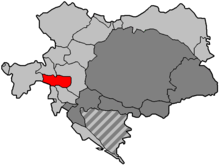
Over the centuries, theGerman language,which carried more prestige, expanded at the expense ofSlovene,but the fact that in the 16th century the Estates of Carinthia could still point out that Carinthia was "aWindicArchduchy",i.e. a sovereign Slovene principality, shows that the Carinthian people were aware of their ancient and pre-German roots.
World War I and Carinthian Plebiscite
[edit]DuringWorld War I,Carinthia experienced a relatively high number of war deaths: thirty-seven for every 1,000 inhabitants. This was higher than in most other German-speaking areas ofAustria-Hungary(exceptGerman South Moravia).[2]
Following the end of the war and the dissolution of Austria-Hungary, the 1919Treaty of Saint-Germainstipulated theCarinthian Canal Valleystretching fromTarvisioas far asPontafel(187 square miles)[3]go toItalyand that the Slovene-speaking areas of the Meža Valley, the Drava Valley area aroundUnterdrauburg,which was afterwards renamedDravograd,and theJezerskoarea (128 square miles of territory)[3]be ceded to the new SHS State. TheKingdom of Serbs, Croats and Slovenes,however, was not satisfied with these parts of the former duchy and also occupied land north of the Karawanks mountain range, including the capital city of Klagenfurt. TheEntentepowers decided on a two-stage referendum, of which the first stage, theCarinthian Plebiscitewas held on 10 October 1920 to determine the fate of Carinthia. The outcome in favour of Austria did not change the borders as decided upon in the Treaty of Saint-Germain.
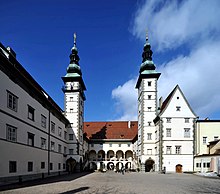

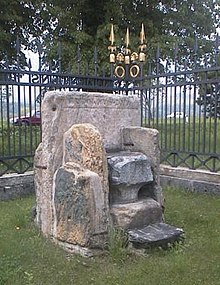
The Austrian part of the former duchy today forms thefederal stateofCarinthia(‹See Tfd›German:Land Kärnten), while the area that was ceded to Italy as a part of the claimed "Julian March"belongs to the autonomousregionofFriuli–Venezia Giulia.Most of the area awarded to Yugoslavia (cf.Slovenian Carinthia) now forms part of the largerCarinthia Statistical RegioninSlovenia.
Area and population
[edit]Area:
- Total: 10,327 km2(3,987 sq mi)
Population(1910 Census):
- Total: 396,228
Linguistic composition
[edit]According to the last Austrian Imperial census of 1910, the Duchy of Carinthia was composed of the following linguistic communities:
Total: 396,228
- German:304,315 (76.80%)
- Slovene:82,212 (20.75%)
- Italian:82 (0.02%)
- Other languages or foreigners: 9,619 (2.43%)
The Austrian censuses did not countethnic groups,nor themother tongue,but the "language of daily interaction" (Umgangssprache).
Religious composition
[edit]Total: 396,228
- Roman Catholics:371,361 (93.72%)
- Protestants:24,299 (6.13%)
- Jewish:341 (0.09%)
- Other religions or unknown: 227 (0.06%)
Dukes of Carinthia
[edit]Various dynasties
[edit]- Berthold I(927–938)
- Henry I(976–978)
- Otto I(978–985)
- Henry I (985–989), again,Duke of Bavaria983–985
- Henry II, Duke of Bavaria(989–995), alsoDuke of Bavaria985–995
- Henry II, Holy Roman Emperor(995–1002), alsoDuke of Bavaria995–1005
- Otto I (1002–1004), again
- Conrad I(1004–1011)
- Adalbero/Albert I (1011–1035)
- Conrad II(1036–1039)
- Henry III, Holy Roman Emperor(1039–1047), alsoDuke of Bavaria1026–1041 andHoly Roman Emperor1046–1056
- Welf(1047–1055)
- Conrad III(1056–1061)
- Berthold II(1061–1077)
House of Sponheim
[edit]
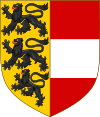
- Henry IV(1122–1123)
- Engelbert(1123–1134)
- Ulrich I(1134–1144)
- Henry V(1144–1161)
- Herman(1161–1181)
- Ulrich II(1181–1201)
- Bernhard(regent from 1199, duke 1202–1256)
- Ulrich III(1256–1269)
Various dynasties
[edit]- Otakar/Otto II (1269–1276), alsoKing of Bohemia1253–1278
- Rudolph I(1276–1286), alsoKing of Germany1273–1291
Gorizia-Tyrol
[edit]- Meinhard(1286–1295)
- Henry VI(1295–1335), alsoKing of Bohemia1306/1307–1310, jointly with his brothers
House of Habsburg
[edit]- Otto IV(1335–1339), jointly with his brother
- Albert II(1335–1358)
- Frederick Ι(1358–1362), jointly with his brother
- Rudolph II(1358–1365)
- Albert III(1365–1379)
Leopoldian line
[edit]- Ernest(1406–1424)
- Frederick ΙΙ(1424–1493)
Habsburg territories reunified in 1458
[edit]- Maximilian(1493–1519), alsoHoly Roman Emperor1508–1519
- Charles I(1519–1558), also Holy Roman Emperor 1519–1556
- Ferdinand I(1521–1564), also Holy Roman Emperor 1558–1564
Inner Austrian Habsburgs
[edit]- Charles II(1564–1590)
- Ferdinand II(1590–1637), also Holy Roman Emperor 1619–1637
Carinthia was unified with the rest of the Habsburg territories again in 1619. SeeList of rulers of Austria
See also
[edit]- Carantania
- Carantanians
- Carinthian Slovenes
- History of Austria
- History of Slovenia
- Black panther (symbol)
Notes and references
[edit]- ^abMediaeval GenealogyArchivedDecember 14, 2007, at theWayback Machine
- ^Rothenburg, G.The Army of Francis Joseph.West Lafayette: Purdue University Press, 1976. p 218.
- ^ab”Kärnten.” Encyclopædia Britannica. Ultimate Reference Suite. Chicago 2010.
External links
[edit]Val Canale/Canal Valley - region of Carinthia now part of Italy
- Duchy of Carinthia
- States and territories disestablished in 1919
- States and territories established in the 970s
- Carinthia
- Dukes of Carinthia
- States of the German Confederation
- Duchies of the Holy Roman Empire
- Austrian Circle
- Subdivisions of Austria-Hungary
- Historical regions in Austria
- Former states and territories in Slovenia
- 970s establishments in the Holy Roman Empire
- 1918 disestablishments in Austria-Hungary
- 976 establishments
- Lands of the Empire of Austria (1867–1918)
- Former duchies



